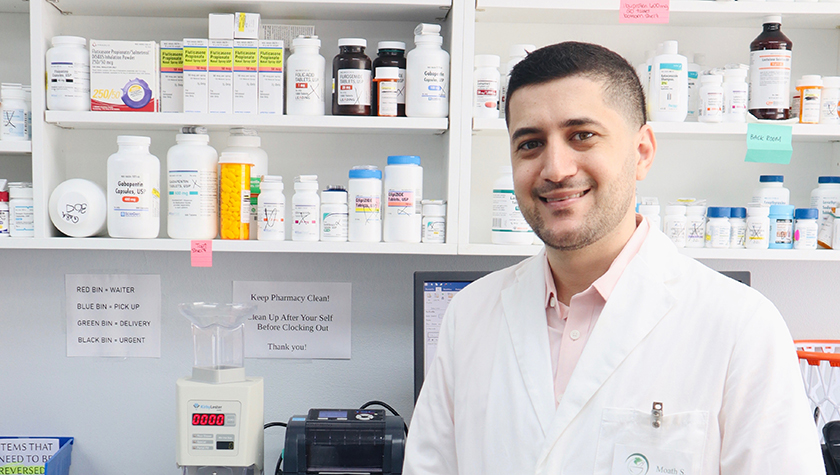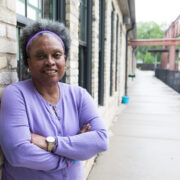
9
December

Associate Professor Olayinka Shiyanbola’s research for diabetes equity among Black and Hispanic patients wins support from the National Institute of Diabetes and Digestive and Kidney Diseases
By Maren Stewart & Katie Gerhards
Overall, U.S. adults have a 40 percent chance of developing diabetes in their lifetime, according to the Centers for Disease Control — a strikingly high figure that climbs even higher for some racial and ethnic minority groups. Hispanic populations have a 30 percent greater risk of developing diabetes, and for African American/Black populations, the risk is doubled compared with white adults.
Hispanic and Black patients who develop this chronic disease also face substantially higher rates of complications, including kidney failure and vision loss, largely due to poor adherence to diabetes medications.
Through years of community-involved research, Olayinka Shiyanbola, associate professor in the University of Wisconsin–Madison School of Pharmacy’s Social and Administrative Sciences Division, discovered two main factors contributing to this trend: misperceptions about diabetes and/or medicines and social determinants of health.
“We are looking beyond individual patient behaviors to see what the unmet social needs are — what the social factors and structural issues are.”
—Olayinka Shiyanbola
To address misperceptions, in 2019, Shiyanbola trained and leveraged peer mentors, who were partnered with study participants to provide culturally appropriate support around managing diabetes medications.
In a new five-year study supported by a prestigious $3.2 million R01 grant from the National Institute of Diabetes and Digestive and Kidney Diseases, Shiyanbola now seeks to understand how peer and clinical support can address social determinants of health and misperceptions.
“We are looking beyond individual patient behaviors to see what the unmet social needs are — what the social factors and structural issues are,” says Shiyanbola. “For diabetes management, especially for marginalized populations, we need to start thinking about how to adapt interventions, how to create interventions that can make impacts and be used in a real-world setting.”
Multifaceted support
Through focus groups with individuals with diabetes, Shiyanbola and her research team identified some specific social determinants of health leading to lower patient outcomes.
“Lack of information was a big one,” she says. “There was not enough information on how to manage diabetes due to access issues.”

Similar to her Peers LEAD project — which leveraged as mentors, African Americans who were successfully managing their diabetes — Shiyanbola’s new project is leveraging community health workers as peer support persons, expanding the scope to include Hispanic participants, as well as more clinical management. The research aims to optimize effective and cost-effective diabetes self-management interventions, tackling medication nonadherence and striving to improve glycemic control.
Shiyanbola is using mixed methods, factorial design, and a multiphase optimization strategy — an engineering-inspired research framework.
“We thought about how to bring in novel methodologies and analytical approaches, so that we can further optimize behavioral, community-engaged pharmacy interventions,” says Shiyanbola.
The NIH-backed study will include four treatment groups: one group will continue seeing their pharmacist as normal, while another will receive culturally appropriate support from a community health worker to address misperceptions and social determinants of health. A third group will get medication therapy management services from a pharmacist, where the pharmacist will be looking over their medication treatment plan and working with their provider to modify it and help manage side effects. A final group will receive support from the community health worker and pharmacist.
“We want to see which of these four treatment groups improves their glycemic control,” says Shiyanbola. Participants’ A1C will be measured at the beginning and end of the six-month intervention to see which group saw the most benefit, and again at the end of 12 months. But the team will also monitor several other outcomes.
“We also want to see which one of them is cost-effective, because that matters to payers and policymakers,” says Shiyanbola. “And then there will be some qualitative interviews to see which one is feasible for participants’ lifestyles, because we want to be able to translate this to the real world.”

Throughout the course of the five-year study, Shiyanbola and her team will follow several cohorts through the process, aiming for a total of more than 350 participants in the Milwaukee area through partnerships with several community partners.
“We can’t do this work without our community partner organizations,” says Shiyanbola.
The intervention will be run through two Milwaukee pharmacies: Hayat Pharmacy and Long Life Pharmacy.
“These pharmacies are really embedded in the community,” says Shiyanbola. “We wanted independent pharmacies that are trusted within the Black and Hispanic communities in Milwaukee.”
Other partners who will help with further community engagement, patient recruitment, and community health worker training include the United Community Center, Milwaukee AHEC (Area Health Education Centers), and the Center for Community Engagement and Health Partnership.
Lifting patient voices
Participants’ A1C levels, pharmacy refills and survey measures, are quantitative measures which can’t tell the whole story about the effectiveness of the intervention they received. That’s why Shiyanbola is using a mixed methods approach, combining this quantitative data with qualitative data, gathered through participant feedback.
“The combination of data allows you to know more about the participant’s perspective,” she says. “Quantitative measures and a cost-effectiveness analysis don’t allow us to understand what the patient thinks in terms of the burden on them in participating in the intervention. Mixed methods allows us to further understand the patient voice about what matters to them, what is feasible for them, what is acceptable to them, and why does it matter.”
Shiyanbola’s team will speak with participants in each of the four treatment groups to create an optimized treatment package, determined not only by what is clinically effective and cost effective, but also what is acceptable — and therefore sustainable — for Black and Hispanic people with diabetes.
“We thought about how to bring in novel methodologies and analytical approaches, so that we can further optimize behavioral, community-engaged pharmacy interventions.”
—Olayinka Shiyanbola
“We are looking at psychosocial factors to see if these interventions are changing behaviors, and how,” she says. “We want to see if it’s reducing personal stress, for example, or increasing self-efficacy or self-confidence to take medicines.”
Working with marginalized populations makes the patient perspective all the more important, Shiyanbola says.
“We just don’t want to provide interventions,” she says. “We want interventions that are culturally acceptable to them. By bringing both types of data together, we can expand beyond, ‘Why does it work?’ from our clinical and policy angles of effectiveness, to ‘Why does it work for these communities?’”
Through this study, Shiyanbola hopes to further elucidate the societal factors, from food insecurity to lack of healthcare access, that influence disease management and outcomes — an investigation that’s picking up steam among health researchers.
“Right now, we have to spend a lot of time in individual behavioral interventions to help patients,” she says. “Now, the field is thinking a little bit bigger, beyond having to change the patient behavior, but to also address external factors and conditions that impact diabetes management.”






